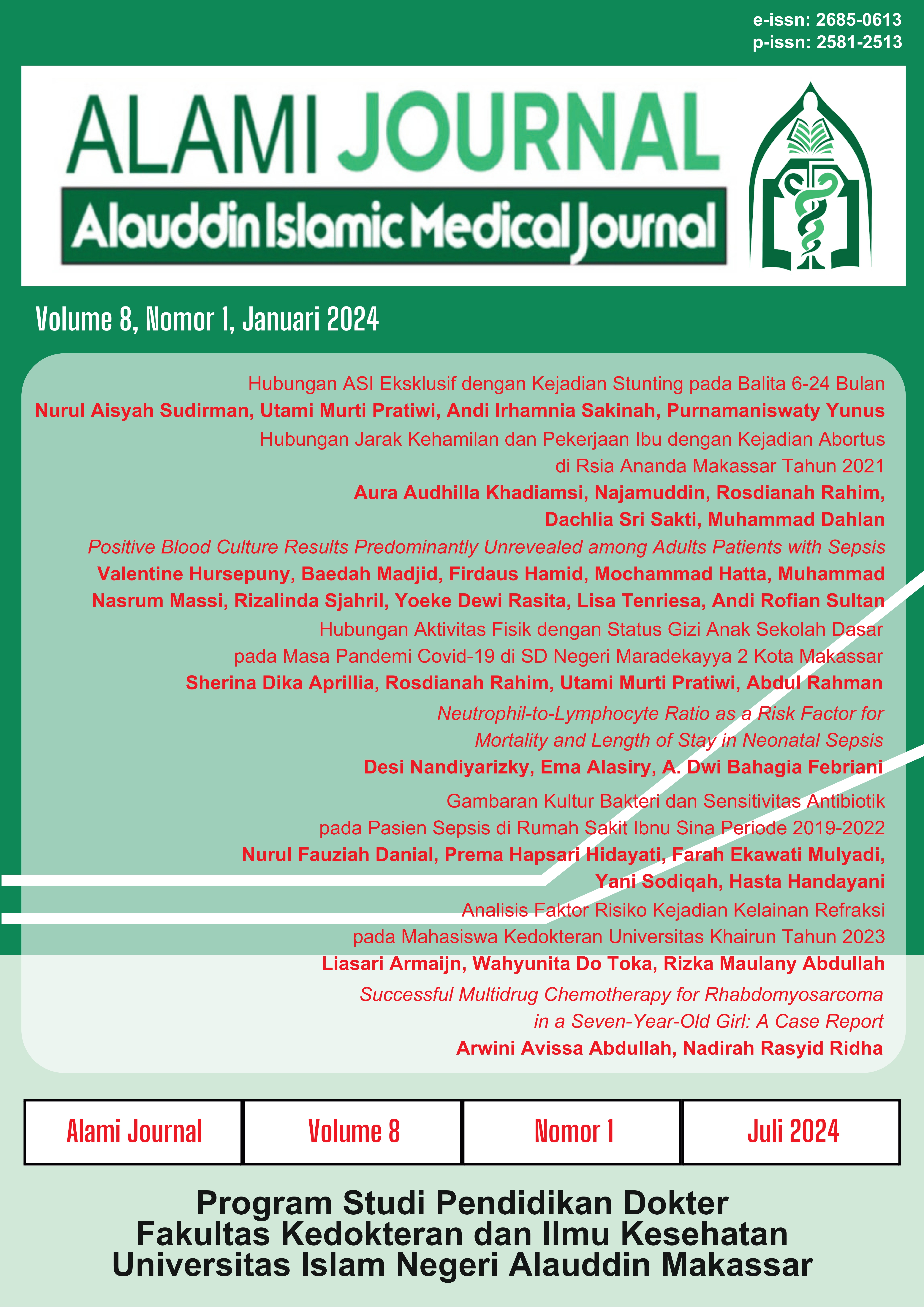Neutrophil-to-Lymphocyte Ratio as a Risk Factor for Mortality and Length of Stay in Neonatal Sepsis
Abstract
The neutrophil-to-lymphocyte ratio (NLR) is inexpensive and included as part of complete blood counts studied in various clinical conditions and sepsis. Alterations in NLR have been associated with disease severity and outcomes. The study aimed to determine whether NRL can be a prognostic marker for mortality/length of stay in neonatal sepsis. This retrospective cohort study examined the relationship between high NLR and mortality/length of stay in neonatal sepsis in neonates treated at RSUP Dr Wahidin Sudirohusodo Makassar from January 2018 to December 2020. Data from 138 neonates with complete medical records were analyzed. The NLR value increased more with mortality outcomes and length of stay less than seven days. No significant association was found between NLR and patient outcomes or length of stay. The study has found no association between NLR and outcomes or length of hospital stay in neonatal sepsis.
References
Li T, Dong G, Zhang M, Xu Z, Hu Y, et al. Association of Neutrophil–Lymphocyte Ratio and the Presence of Neonatal Sepsis. Journal of Immunology Research. 2020 Dec 2;2020:1–8.
Fleischmann C, Reichert F, Cassini A, Horner R, Harder T, et al. Global incidence and mortality of neonatal sepsis: a systematic review and meta-analysis. Archives of Disease in Childhood. 2021;106(8):745–52.
Alkan Ozdemir S, Arun Ozer E, Ilhan O, Sutcuoglu S. Can neutrophil to lymphocyte ratio predict late‐onset sepsis in preterm infants? Journal of Clinical Laboratory Analysis. 2018;32(4).
Jovičić M, Milosavljević MN, Folić M, Pavlović R, Janković SM. Predictors of Mortality in Early Neonatal Sepsis: A Single-Center Experience. Medicina (Bounes Aires). 2023;59(3):604.
Gude SS, Peddi NC, Vuppalapati S, Venu Gopal S, Marasandra Ramesh H, et al. Biomarkers of Neonatal Sepsis: From Being Mere Numbers to Becoming Guiding Diagnostics. Cureus. 2022;14(3):1-10.
Li T, Dong G, Zhang M, Xu Z, Hu Y, et al. Association of Neutrophil–Lymphocyte Ratio and the Presence of Neonatal Sepsis. Journal of Immunology Research. 2020 Dec 2;2020:1–8.
Xin Y, Shao Y, Mu W, Li H, Zhou Y, et al. Accuracy of the neutrophil-to-lymphocyte ratio for the diagnosis of neonatal sepsis: a systematic review and meta-analysis. BMJ Open. 2022;12(12):1-7.
Capone M, Giannarelli D, Mallardo D, Madonna G, Festino L, et al. Baseline neutrophil-to-lymphocyte ratio (NLR) and derived NLR could predict overall survival in patients with advanced melanoma treated with nivolumab. The Journal for Immunotherapy of Cancer. 2018;6(1):1-7.
Lim H, Sukmawati M, Artana WD, Kardana M, Putra PJ. Validity of neutrophil lymphocyte count ratio in neonatal sepsis. International journal of health sciences (Qassim). 2021;5(2):53-61
Roestanajie J, Ali Shodikin M. Relation of NLR Value and Mortality Rate in Neonatal Sepsis. Smart Medical Journal. 2023;6(1):1-5.
Sumitro KR, Utomo MT, Widodo ADW. Neutrophil-to-Lymphocyte Ratio as an Alternative Marker of Neonatal Sepsis in Developing Countries. Oman Medical Journal. 2021;36(1):e214.
Milton R, Gillespie D, Dyer C, Taiyari K, Carvalho MJ, et al. Neonatal sepsis and mortality in low-income and middle-income countries from a facility-based birth cohort: an international multisite prospective observational study. Lancet Global Health. 2022;10(5):661–72.
Mersha A, Worku T, Shibiru S, Bante A, Molla A, et al. Neonatal sepsis and associated factors among newborns in hospitals of Wolaita Sodo Town, Southern Ethiopia. Research and Reports in Neonatology. 2019; 9:1–8.
Sumitro KR, Utomo MT, Widodo ADW. Neutrophil-to-Lymphocyte Ratio as an Alternative Marker of Neonatal Sepsis in Developing Countries. Oman Medical Journal. 2021;36(1):e214–e214.
Kayalar AE, Çakmak Çelik F, Köylü RC, Ekşi MŞ, Çalışaneller AT. Increased Neutrophil Lymphocyte Ratio Could be Predictive for Higher Mortality in Preterm Infants with Intraventricular Hemorrhage. World Neurosurgery. 2023;175: 1191–6.
Panda SK, Nayak MK, Rath S, Das P. The Utility of the Neutrophil-Lymphocyte Ratio as an Early Diagnostic Marker in Neonatal Sepsis. Cureus. 2021 Jan 24;
Das A, Ray S, Chattopadhyay A, Hazra A, Mondal R. Gestation-wise Reference Ranges of Neutrophil Counts in Indian Newborns. Oman Medical Journal. 2019 Mar 18;34(2):131–6.
Christensen RD, Del Vecchio A, Henry E. Expected erythrocyte, platelet and neutrophil values for term and preterm neonates. The Journal of Maternal-Fetal & Neonatal Medicine. 2012 Oct 2;25(sup5):77–9.
Widjaja H, Rusmawatiningtyas D, Makrufardi F, Arguni E. Neutrophil lymphocyte ratio as predictor of mortality in pediatric patients with bacterial meningitis: A retrospective cohort study. Annals of Medicine & Surgery. 2022 Jan;73.
Mu Y, Wang H. Association of neutrophil to lymphocyte ratio with preterm necrotizing enterocolitis: a retrospective case-control study. BMC Gastroenterology. 2022 Dec 17;22(1):248.
Liang P, Yu F. Value of CRP, PCT, and NLR in Prediction of Severity and Prognosis of Patients With Bloodstream Infections and Sepsis. Frontiers in Surgery. 2022 Mar 7;9.
Panda SK, Panda SS, Pradhan DD, Nayak MK, Ghosh A, et al. Comparison of Hematological and Biochemical Parameters of SARS-CoV-2-Positive and -Negative Neonates of COVID-19 Mothers in a COVID-19 Hospital, Odisha State. Cureus. 2022;14(4):1-7
Zhong X, Ma A, Zhang Z, Liu Y, Liang G. Neutrophil-to-lymphocyte ratio as a predictive marker for severe pediatric sepsis. Translational Pediatrics. 2021;10(3):657–65.
Chetana S, Xiangying H. Neutropenia in Premature Infants. Journal of Pediatrics, Perinatology and Child Health. 2019; 3(1):1-9.
Copyright (c) 2024 Desi Nandiyarizky, Ema Alasiry, A. Dwi Bahagia Febriani

This work is licensed under a Creative Commons Attribution-NonCommercial-ShareAlike 4.0 International License.
Once an article was published in the journal, the author(s) are: granted to the journal right licensed under Creative Commons License Attribution that allows others to share the work with an acknowledgement of the work's authorship. permitted to publish their work online in third parties as it can lead wider dissemination of the work. continue to be the copyright owner and allow the journal to publish the article with the CC BY-NC-SA license receiving a DOI (Digital Object Identifier) of the work.


